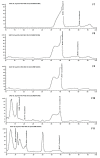Sechium edule (Jacq.) Swartz, a New Cultivar with Antiproliferative Potential in a Human Cervical Cancer HeLa Cell Line
- PMID: 28757593
- PMCID: PMC5579592
- DOI: 10.3390/nu9080798
Sechium edule (Jacq.) Swartz, a New Cultivar with Antiproliferative Potential in a Human Cervical Cancer HeLa Cell Line
Abstract
The Sechium edule Perla Negra cultivar is a recently-obtained biological material whose progenitors are S. edule var. nigrum minor and S. edule var. amarus silvestrys, the latter of which has been reported to have antiproliferative activity against the HeLa P-388 and L-929 cancer cell lines. The present study aimed to determine if the methanolic extract of the fruit of the Perla Negra cultivar had the same biological activity. The methanolic extract was phytochemically characterized by thin layer chromatography (TLC) and column chromatography (CC), identifying the terpenes and flavonoids. The compounds identified via high performance liquid chromatography (HPLC) were Cucurbitacins B, D, E, and I for the terpene fractions, and Rutin, Phlorizidin, Myricetin, Quercetin, Naringenin, Phloretin, Apigenin, and Galangin for the flavonoid fractions). Biological activity was evaluated with different concentrations of the methanolic extract in the HeLa cell line and normal lymphocytes. The methanolic extract inhibited the proliferation of HeLa cells (IC50 1.85 µg·mL-1), but the lymphocytes were affected by the extract (IC50 30.04 µg·mL-1). Some fractions, and the pool of all of them, showed inhibition higher than 80% at a concentration of 2.11 µg·mL-1. Therefore, the biological effect shown by the methanolic extract of the Perla Negra has some specificity in inhibiting tumor cells and not normal cells; an unusual feature among molecules investigated as potential biomedical agents.
Keywords: Perla Negra; biological activity; cancer; chayote.
Conflict of interest statement
The authors declare that they have no conflicts of interest. The funding sponsors did not have any role in the design of the study; collection, analyses, or interpretation of data; writing of the manuscript; or decision to publish the results.
Figures






References
-
- Flores M.E. The chayote, Sechium edule Swartz (Cucurbitaceae) [(accessed on 30 March 2017)];Rev. Biol. Trop. 1989 37:1–54. Available online: https://www.ncbi.nlm.nih.gov/pubmed/2690200. - PubMed
-
- Rzedowski J. Aspectos de las plantas ornamentales mexicanas. Chapingo Serie Hortic. 1995;1:5–7.
-
- Lira-Saade R. Promoting the Conservation and Use of Underutilized and Neglected Crops. 8. Institute of Plant Genetics and Crop Plant Research; Gatersleben/International Plant Genetic Resources Institute; Rome, Italy: 1996. [(accessed on 29 March 2017)]. Chayote. Sechium edule (Jacq.) Sw. p. 57. Available online: http://pdf.usaid.gov/pdf_docs/Pnach876.pdf.
-
- Avendaño-Arrazate C.H., Cadena-Iñiguez J., Arevalo-Galarza M.L.C., Campos-Rojas E., Cisneros-Solano V.M., Aguirre-Medina J.F. Las Variedades del Chayote Mexicano, Recurso Ancestral con Potencial de Comercialización. Grupo Interdisciplinario de Investigación en Sechium edule en México AC (GISeM); Estado de México, Mexico: 2010. [(accessed on 29 March 2017)]. Available online: http://snics.mx/sinarefi/biblioteca/Las%20variedades%20dek%20chayote%20m....
-
- Cambar P.J., Portillo P., Tabora F.E., de Pineda L., Tovar O., Casco J., Alvarado C., Díaz G., Casco B., Cantillo L. Estudio preliminar sobre las acciones farmacológicas de Sechium edule. [(accessed on 29 March 2017)];Rev. Méd. Hondur. 1980 48:97–99. Available online: http://www.bvs.hn/RMH/pdf/1980/pdf/Vol48-4-1980-3.pdf.
MeSH terms
Substances
LinkOut - more resources
Full Text Sources
Other Literature Sources

